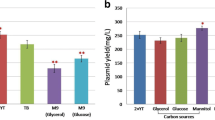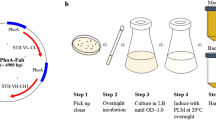Abstract
Escherichia coli based systems, are favoured hosts for recombinant protein expression. However, Low Fab expression and high production costs are major obstacles for manufacturers. To enhance process economics, an efficient, well-defined upstream process is crucial. This paper presents a systematic approach of process optimization for production of Fab fragment, ranibizumab. A two-step design of experiments (DOE) approach has been used. Six variables were examined: post-induction temperature, postinduction time, inducer concentration, agitation speed, media pH, and cell density at induction time (induction OD). These parameters were evaluated for their effect on biomass concentration, protein titre, impurity level, and light to heavy chain ratio. First, screening DOE with fractional factorial design was performed to shortlist important process parameters. Next, response surface study based on central composite design was conducted for identifying the operating range for the significant process parameters. Induction OD, inducer concentration, pH, and temperature were identified as significant parameters with their respective optima at 1.2 OD, 1 mM, 7.4 pH, and 35°C, respectively. Operating under these conditions resulted in formation of 0.051 g protein/g inclusion bodies, 4.99 g/L biomass concentration, and light chain to heavy chain equal expression ratio (LC:HC=0.98), with 8.2% impurity. Additionally, based on the predictions, we found that temperature, induction OD, and their interactions significantly affect the LC:HC ratio and impurity level, and need to be tightly controlled. This study has highlighted the importance of fine-tuning of physical parameters for production of Fab fragments and to control impurity expression in microbial host systems.
Similar content being viewed by others
Availability of Data and Materials
Ranibizumab periplasmic double copy under the Accession Number BankIt2302631 Seq2:MN931856.
References
Azarian, B., A. Azimi, M. Sepehri, V. Samimi Fam, F. Rezaie, Y. Talebkhan, V. Khalaj, and F. Davami (2019) Proteomics investigation of molecular mechanisms affected by EnBase culture system in anti-VEGF fab fragment producing E. coli BL21 (DE3). Prep. Biochem. Biotechnol. 49: 48–57.
Lange, S., J. Schmitt, and R. D. Schmid (2001) High-yield expression of the recombinant, atrazine-specific Fab fragment K411B by the methylotrophic yeast Pichia pastoris. J. Immunol. Methods. 255: 103–114.
Rosano, G. L. and E. A. Ceccarelli (2014) Recombinant protein expression in Escherichia coli: advances and challenges. Front. Microbiol. 5: 172.
Patil, R. S., A. Anupa, J. A. Gupta, and A. S. Rathore (2022) Challenges in expression and purification of functional fab fragments in E. coli: current strategies and perspectives. Fermentation. 8: 175.
Hsu, C. C., O. Thomas, and T. Overton (2016) Periplasmic expression in and release of Fab fragments from Escherichia coli using stress minimisation. J. Chem. Technol. Biotechnol. 91: 815–822.
Kumar, D., J. Batra, C. Komives, and A. S. Rathore (2019) QbD based media development for the production of Fab fragments in E. coli. Bioengineering (Basel). 6: 29.
Gutiérrez-González, M., C. Farías, S. Tello, D. Pérez-Etcheverry, A. Romero, R. Zúñiga, C. H. Ribeiro, C. Lorenzo-Ferreiro, and M. C. Molina (2019) Optimization of culture conditions for the expression of three different insoluble proteins in Escherichia coli. Sci. Rep. 9: 16850.
Ou, J., L. Wang, X. Ding, J. Du, Y. Zhang, H. Chen, and A. Xu (2004) Stationary phase protein overproduction is a fundamental capability of Escherichia coli. Biochem. Biophys. Res. Commun. 314: 174–180.
Peti, W. and R. Page (2007) Strategies to maximize heterologous protein expression in Escherichia coli with minimal cost. Protein Expr. Purif. 51: 1–10.
Papaneophytou, C. P. and G. Kontopidis (2014) Statistical approaches to maximize recombinant protein expression in Escherichia coli: a general review. Protein Expr. Purif. 94: 22–32.
Montgomery, D. C. (2019) Design and Analysis of Experiments. 10th ed. Wiley.
Kumar, V., A. Bhalla, and A. S. Rathore (2014) Design of experiments applications in bioprocessing: concepts and approach. Biotechnol. Prog. 30: 86–99.
Chambers, S. P. and S. E. Swalley (2009) Designing experiments for high-throughput protein expression. pp. 19–29. In: S. A. Doyle (ed.). High Throughput Protein Expression and Purification. Humana Press.
Kasli, I. M., O. R. T. Thomas, and T. W. Overton (2019) Use of a design of experiments approach to optimise production of a recombinant antibody fragment in the periplasm of Escherichia coli: selection of signal peptide and optimal growth conditions. AMB Express. 9: 5.
Behravan, A. and A. Hashemi (2021) RSM-based model to predict optimum fermentation conditions for soluble expression of the antibody fragment derived from 4D5MOC-B humanized Mab in SHuffle™ T7 E. coli. Iran. J. Pharm. Res.: IJPR. 20: 254–266.
Chen, H., J.-S. Chen, P. Paerhati, T. Jakos, S.-Y. Bai, J.-W. Zhu, and Y.-S. Yuan (2021) Strategies and applications of antigen-binding fragment (Fab) production in Escherichia coli. Pharm. Fronts. 3: e39–e49.
Tripathi, N. K. (2016) Production and purification of recombinant proteins from Escherichia coli. ChemBioEng Rev. 3: 116–133.
Berrow, N. S., K. Büssow, B. Coutard, J. Diprose, M. Ekberg, G. E. Folkers, N. Levy, V. Lieu, R. J. Owens, Y. Peleg, C. Pinaglia, S. Quevillon-Cheruel, L. Salim, C. Scheich, R. Vincentelli, and D. Busso (2006) Recombinant protein expression and solubility screening in Escherichia coli: a comparative study. Acta. Crystallogr. D Biol. Crystallogr. 62: 1218–1226.
Donovan, R. S., C. W. Robinson, and B. R. Glick (1996) Review: optimizing inducer and culture conditions for expression of foreign proteins under the control of the lac promoter. J. Ind. Microbiol. 16: 145–154.
Huleani, S., M. R. Roberts, L. Beales, and E. H. Papaioannou (2022) Escherichia coli as an antibody expression host for the production of diagnostic proteins: significance and expression. Crit. Rev. Biotechnol. 42: 756–773.
Priyanka, P. and A. S. Rathore (2022) A novel strategy for efficient expression of an antibody fragment in Escherichia coli: ranibizumab as a case study. J. Chem. Technol. Biotechnol. 97: 42–54.
Galloway, C. A., M. P. Sowden, and H. C. Smith (2003) Increasing the yield of soluble recombinant protein expressed in E. coli by induction during late log phase. Biotechniques. 34: 524–530.
Ramírez, O. T., R. Zamora, G. Espinosa, E. Merino, F. Bolívar, and R. Quintero (1994) Kinetic study of penicillin acylase production by recombinant E. coli in batch cultures. Process Biochem. 29: 197–206.
Papaneophytou, C. P., V. Rinotas, E. Douni, and G. Kontopidis (2013) A statistical approach for optimization of RANKL overexpression in Escherichia coli: purification and characterization of the protein. Protein Expr. Purif. 90: 9–19.
Yin, Y. and C. W. Carter Jr (1996) Incomplete factorial and response surface methods in experimental design: yield optimization of tRNA(Trp) from in vitro T7 RNA polymerase transcription. Nucleic Acids Res. 24: 1279–1286.
Antoniou, G., I. Papakyriacou, and C. Papaneophytou (2017) Optimization of soluble expression and purification of recombinant human rhinovirus type-14 3C protease using statistically designed experiments: isolation and characterization of the enzyme. Mol. Biotechnol. 59: 407–424.
Dvorak, P., L. Chrast, P. I. Nikel, R. Fedr, K. Soucek, M. Sedlackova, R. Chaloupkova, V. de Lorenzo, Z. Prokop, and J. Damborsky (2015) Exacerbation of substrate toxicity by IPTG in Escherichia coli BL21 (DE3) carrying a synthetic metabolic pathway. Microb. Cell Fact. 14: 201.
Marini, G., M. D. Luchese, A. P. C. Argondizzo, A. C. M. A. de Góes, R. Galler, T. L. M. Alves, M. A. Medeiros, and A. L. Larentis (2014) Experimental design approach in recombinant protein expression: determining medium composition and induction conditions for expression of pneumolysin from Streptococcus pneumoniae in Escherichia coli and preliminary purification process. BMC Biotechnol. 14: 1.
Mohajeri, A., Y. Pilehvar-Soltanahmadi, J. Abdolalizadeh, P. Karimi, and N. Zarghami (2016) Effect of culture condition variables on human endostatin gene expression in Escherichia coli using response surface methodology. Jundishapur J. Microbiol. 9: e34091.
Larentis, A. L., J. F. M. Q. Nicolau, G. dos Santos Esteves, D. T. Vareschini, F. V. R. de Almeida, M. G. dos Reis, R. Galler, and M. A. Medeiros (2014) Evaluation of pre-induction temperature, cell growth at induction and IPTG concentration on the expression of a leptospiral protein in E. coli using shaking flasks and microbioreactor. BMC Res. Notes. 7: 671.
Swalley, S. E., J. R. Fulghum, and S. P. Chambers (2006) Screening factors effecting a response in soluble protein expression: formalized approach using design of experiments. Anal. Biochem. 351: 122–127.
De León, A., H. Jiménez-Islas, M. González-Cuevas, and A. P. B. de la Rosa (2004) Analysis of the expression of the Trichoderma harzianum ech42 gene in two isogenic clones of Escherichia coli by surface response methodology. Process Biochem. 39: 2173–2178.
Beigi, L., H. R. Karbalaei-Heidari, and M. Kharrati-Kopaei (2012) Optimization of an extracellular zinc-metalloprotease (SVP2) expression in Escherichia coli BL21 (DE3) using response surface methodology. Protein Expr. Purif. 84: 161–166.
Acknowledgements
Author Rucha S. Patil would like to thank Department of Biotechnology, Ministry of Science and Technology, New Delhi, for providing DBT-JRF Fellowship grant during her PhD (Fellow number DBT/2017/IIT-D/964).
Funding
Authors would like to acknowledge funding support from Department of Biotechnology, Ministry of Science and Technology (File number BT/COE/34/SP15097/2015) and by Biotechnology Industry Research Assistance Council (Reference number BT/NBM0160/04/19).
Author information
Authors and Affiliations
Contributions
Rucha S. Patil: Conceptualization, Methodology, Formal analysis, Validation, Investigation, Writing–original draft, reviewing and editing. Nidhi Upadhyay: Methodology, Formal analysis, Validation, Investigation. Anurag S. Rathore: Conceptualization, Resources, Writing–review & editing, Supervision, Project administration, Funding acquisition.
Corresponding author
Ethics declarations
The authors declare no conflict of interest.
Neither ethical approval nor informed consent was required for this study.
Additional information
Publisher’s Note
Springer Nature remains neutral with regard to jurisdictional claims in published maps and institutional affiliations.
Electronic Supplementary Material
Rights and permissions
About this article
Cite this article
Patil, R.S., Upadhyay, N. & Rathore, A.S. Optimization of Process Parameters for Enhanced Production of Ranibizumab in Escherichia coli. Biotechnol Bioproc E 28, 386–397 (2023). https://doi.org/10.1007/s12257-022-0323-2
Received:
Revised:
Accepted:
Published:
Issue Date:
DOI: https://doi.org/10.1007/s12257-022-0323-2




